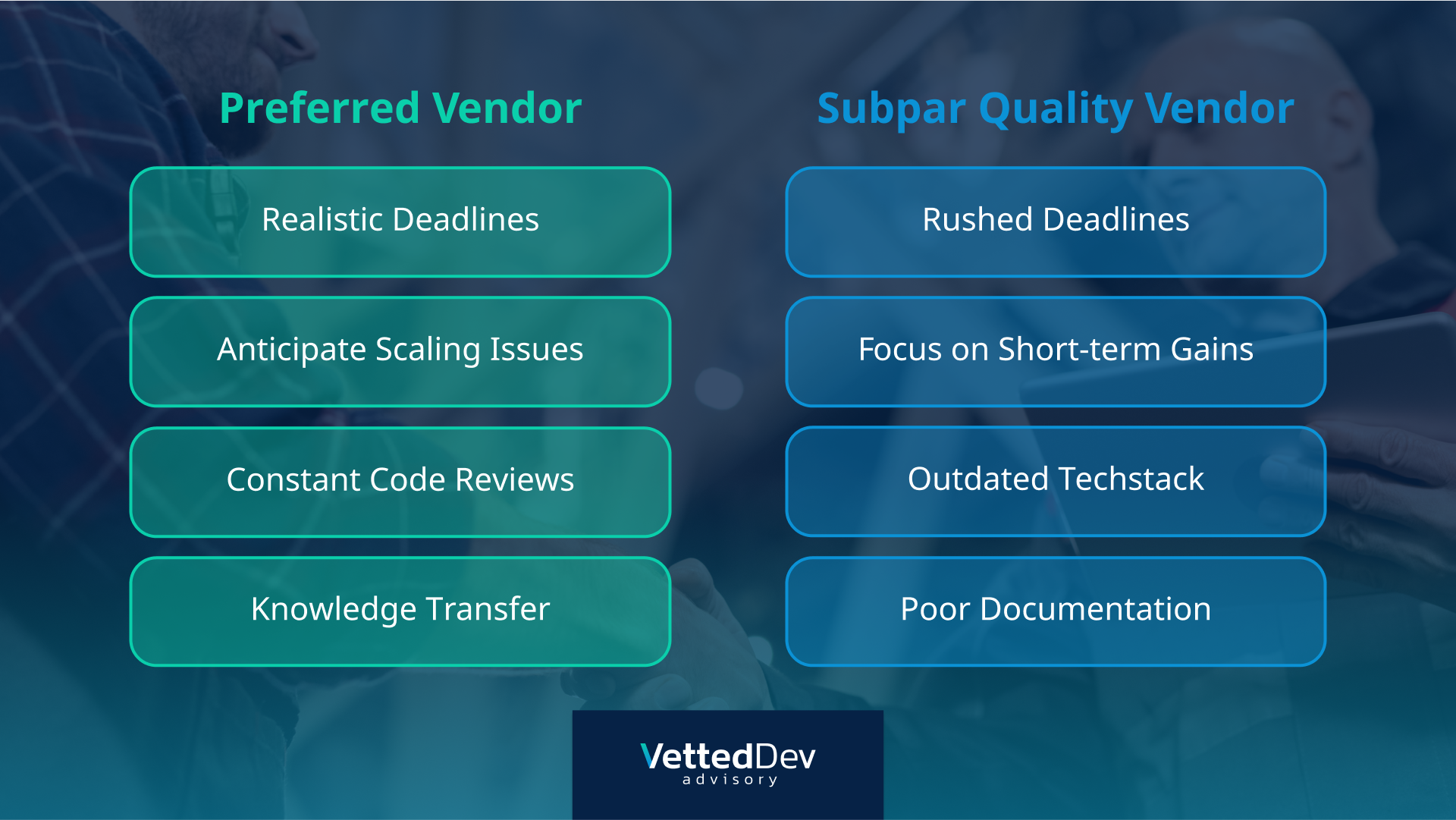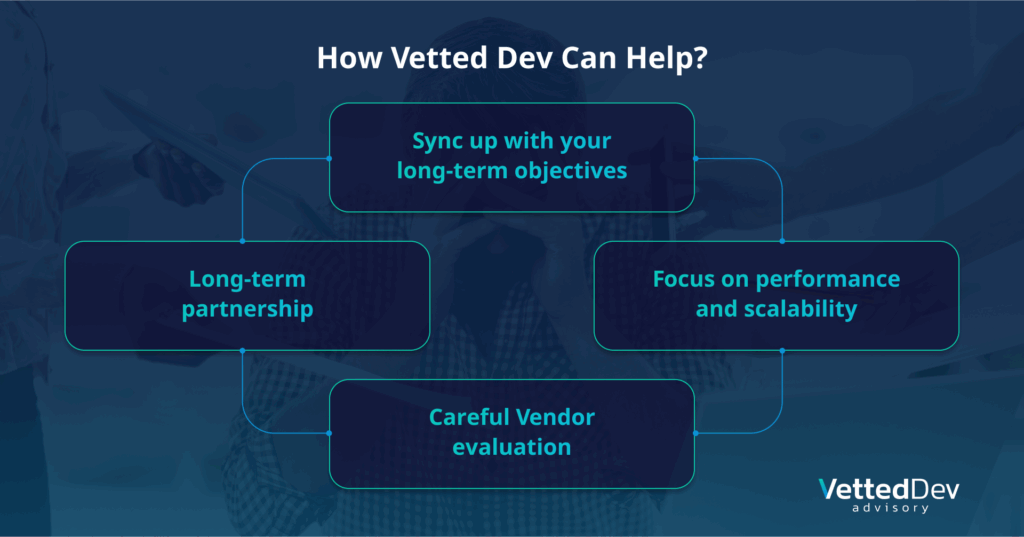The Hidden Cost: Why Ignoring Technical Debt Can Derail Your AI and Digital Transformation Projects
By VettedDev.net
In the fast-paced world of AI development, SaaS innovation, and digital transformation, the pressure to build fast and spend smartly is enormous.
Founders and C-level executives often face a critical decision: Which vendor should I trust with my next big software initiative?
In that decision, one dangerous factor is too often overlooked: technical debt.
Choosing the wrong vendor or optimizing for the cheapest bid can saddle your company with technical debt that grows quietly in the background until one day it breaks your product, your budget, or your reputation.
At Vetted Dev, we’ve spent years guiding businesses to make the right vendor choices. One pattern we see over and over: Ignoring technical debt during vendor selection is one of the most expensive mistakes a company can make.
In this article, we’ll unpack:
- What technical debt actually is (and isn’t)
- How it creeps in through bad vendor choices
- The hidden and long-term risks it creates
- Why fast or cheap vendors aren’t always the win they seem to be
- How Vetted Dev helps our clients avoid this minefield entirely
What is Technical Debt, Really?
Technical debt refers to the future cost of choosing an easier, quicker, or cheaper solution today instead of doing things properly.
Think of it like cutting corners when building a house:
- Maybe you skip proper insulation to save money.
- Everything looks fine on move-in day.
- But months later, you’re paying huge heating bills, or facing expensive repairs when mold appears.
In software, technical debt shows up as:
- Poorly structured codebases
- Incomplete documentation
- Fragile integrations
- Outdated libraries or frameworks
- Hasty architecture choices
At first, things work. Maybe you even ship faster.
But each rushed decision adds hidden complexity that makes future changes, scaling, or improvements slower, more expensive, and riskier.

How Bad Vendor Choices Create Massive Technical Debt
When companies select a vendor without properly vetting them or when they optimize purely for cost or speed technical debt becomes almost inevitable.
Here’s how it typically happens:
1. Rushed Deadlines Trump Sound Architecture
Some vendors promise impressive timelines that seem “too good to be true.” Often, they are.
Behind the scenes, these vendors may skip critical steps like:
- Designing scalable architecture
- Conducting proper code reviews
- Implementing automated testing
- Thinking about maintainability
They might get your MVP out quickly, but future iterations will be stuck in a slow, costly web of rework.
2. Under-Qualified Teams
Not all vendors are created equal. Some staff your project with junior developers, freelancers, or under-trained teams to cut costs.
These teams may not have the skills to:
- Anticipate scaling issues
- Build flexible APIs
- Future-proof your tech stack
Poor foundational decisions become shackles around your product’s ankles as you grow.
3. No Focus on Documentation or Knowledge Transfer
Some vendors skip documentation to save effort, assuming they’ll always be around to fix things.
When you try to switch vendors later or bring work in-house you’re left with a cryptic, fragile system that new developers struggle to understand.
Knowledge silos = massive hidden risk.
4. Short-Term Mindset
A vendor that’s focused purely on “winning this deal” rather than becoming a long-term partner will optimize for their short-term gain, not your long-term success.
If your vendor isn’t designing for extensibility, modularity, and future growth, you’re already accumulating debt.

Real-World Risks of Ignoring Technical Debt
Technical debt might seem harmless at first – until it isn’t.
Here’s what ignoring technical debt can really cost you:
📈 Slower Time-to-Market
Ironically, the race to launch quickly can later make new features painfully slow to develop.
Tech debt acts like sludge in your development process, turning simple updates into major undertakings.
💸 Skyrocketing Maintenance Costs
Every quick-and-dirty decision creates hidden maintenance obligations.
Over time, your engineering team spends more time fixing than building driving up costs without delivering value.
🔒 Security Vulnerabilities
Messy codebases and outdated dependencies aren’t just inefficient, they’re dangerous.
Technical debt often opens up security holes that put your product and your users at risk.
💀 Failed Migrations and Scalability Dead Ends
Need to migrate to the cloud, upgrade your stack, or serve 10x more users?
Heavy technical debt can make these transitions practically impossible without a complete, expensive rebuild.
🧠 Employee and Vendor Turnover Chaos
High technical debt makes onboarding new engineers a nightmare.
Talent leaves when they get frustrated working on “spaghetti code.” New vendors charge higher rates just to take over a messy system.
🧨 Reputation Damage
In SaaS and tech, your product is your brand.
Frequent bugs, slow performance, and security breaches kill customer trust, and customers don’t care whether the blame lies with your original vendor. They’ll leave.
Why “Cheapest” is Almost Never “Best”
Founders and executives are under pressure to control costs. That’s understandable.
But when it comes to AI initiatives, SaaS platforms, or digital transformation, selecting a vendor based purely on the lowest bid often results in dramatically higher total costs later.
Initial savings often = long-term disasters.
Here’s why:
- Cheap vendors often lack mature processes and senior talent.
- They cut critical steps like QA, architecture reviews, or scalability testing.
- They have less incentive to deliver maintainable, future-proof systems.
- Communication issues often emerge, leading to misunderstandings and missed expectations.
In technology, the old adage applies: “You get what you pay for.”
Broader Causes of Technical Debt (Beyond Just Bad Vendors)
It’s not only vendor selection that leads to technical debt. Other common causes include:
- Founders forcing artificial deadlines (“We must launch by this conference!”)
- Product teams constantly shifting scope without allowing re-architecture
- Choosing trendy tech stacks without evaluating long-term viability
- Failing to prioritize tech hygiene (e.g., refactoring, test automation)
But vendor quality is a huge variable and one of the few you control upfront.

How Vetted Dev Helps You Avoid the Technical Debt Trap
At Vetted Dev, we exist to make sure you never have to learn these lessons the hard way.
We help SaaS founders and SMB leaders choose the right vendor the first time vendors who not only build great products but build them right.
Here’s how:
🔎 Deep Vendor Screening
We evaluate vendors based on:
- Technical rigor
- Past performance
- Architecture best practices
- Code quality
- Team seniority
- Communication and project management maturity
🎯 Alignment With Your Long-Term Vision
We don’t just look at what you want to build today. We align vendors who can support your growth trajectory over years, not just months.
🧰 Emphasis on Sustainability and Scalability
We prioritize vendors who:
- Build for future growth
- Document properly
- Plan for maintenance and extensibility
- Implement best practices from day one
🤝 True Partnership, Not Just Procurement
We aren’t a directory. We’re your strategic partner in building a resilient, scalable technology foundation.

Conclusion: Don’t Mortgage Your Company’s Future
Technical debt is like financial debt: a little, managed well, can be strategic.
But uncontrolled technical debt, especially the kind that creeps in when you choose the wrong development partner can destroy timelines, budgets, morale, and brands.
Don’t let short-term thinking or cost-driven vendor selection put your company’s future at risk.
At Vetted Dev, we exist to guide you safely through the complex vendor landscape, so you can innovate, grow, and lead with confidence.
For more insights on finding the right outsourcing partner? Visit VettedDev.net for guides, tips, and curated recommendations.
